|
When the tunnel was first opened the responsibility for policing was carried out initially on a 6 month basis by then Liverpool City Police and Birkenhead Borough Police, this created a number of problems firstly, a Police Officer at the time had limited jurisdiction unlike Police Officers today who have the authority of constables anywhere in England and Wales. The boundary of the Mersey tunnel fell between two counties, Liverpool in the county of Lancashire and Birkenhead in the county of Cheshire (the county boundary being near the centre of the tunnel). The duty police officers were reluctant to take directions from the Mersey tunnel inspectorate, as they were not police officers so this caused operational problems.
Neither the Mersey tunnel authority or the Police force policing the tunnel were satisfied with these arrangements as a consequence the Mersey tunnel authority sent a deputation to the Home Office for permission to form their own police force, this request was granted but the Home Office made it clear the cost of a tunnel police force would be borne by the MTJC. The power given to the tunnel authority was under section 105 of the 1936 Liverpool Corporation Act, section 105 of the Act states the MTJC shall have the power to appoint any of their officers or servants to act as special constables for the policing of the tunnel, it's approaches and martial ling areas governed by the Mersey tunnel by-laws.
This act caused yet more problems as Special Constables cannot receive payment as a traffic officer as described in the Mersey tunnel by-laws, but held the office of constable. To comply with the jurisdiction of policing both counties the Mersey tunnel police officer had to swear on oath in both Liverpool and Birkenhead (see notes 1) as a result in January 1936 the Mersey Tunnel Police came into being taking over from Liverpool City Police and Birkenhead Borough Police. The establishment on formation was 2 Inspectors, 4 Sergeants and 14 Constables who carried out regular patrols using motorcycle combinations. To ensure regular patrols were maintained a running card was assigned to each officer along with a running time.
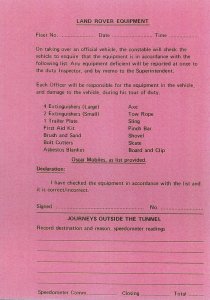 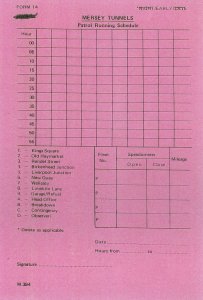 A running card determined the time each officer would do his patrols for example; Constable A would be allocated on the hour and half hour at Birkenhead entrance. Constable B on the hour and half hour at the Liverpool entrance. Constable C fifteen minutes past and forty five minutes to the hour and so on) meaning in theory that at least two patrols would be inside the tunnel travelling in opposite directions at regular intervals Patrols had to use the side lane which was called the 'slow lane' as heavy goods vehicles had to use this lane, even taking into account a patrol being stuck behind a heavy goods vehicle travelling at 15 miles an hour the patrol is going to be out of the tunnel in 4 minutes, as a consequence of this a patrol was never at the right entrance at the right time. All Mersey tunnel police officers heaved a sigh of relief when in 1972 the running cards were phased out, trusting a police officer to carry out patrol under their own initiative.
A running card determined the time each officer would do his patrols for example; Constable A would be allocated on the hour and half hour at Birkenhead entrance. Constable B on the hour and half hour at the Liverpool entrance. Constable C fifteen minutes past and forty five minutes to the hour and so on) meaning in theory that at least two patrols would be inside the tunnel travelling in opposite directions at regular intervals Patrols had to use the side lane which was called the 'slow lane' as heavy goods vehicles had to use this lane, even taking into account a patrol being stuck behind a heavy goods vehicle travelling at 15 miles an hour the patrol is going to be out of the tunnel in 4 minutes, as a consequence of this a patrol was never at the right entrance at the right time. All Mersey tunnel police officers heaved a sigh of relief when in 1972 the running cards were phased out, trusting a police officer to carry out patrol under their own initiative.
As a Primary duty of the Mersey Tunnel Police then and now is to ensure that traffic using the tunnel or approach roads do so as quickly and safely as possible and to deal with anything or persons that prevent it from doing so. It was important that regular patrols were maintained. Before the introduction of CCTV a breakdown if not dealt with quickly could lead to a major build back of traffic in less than 5 minutes leading to frustrated motorists who may attempt change lanes, this in itself can create a major problem as it could lead to a traffic accident.
As well as mobile patrols there was and still is a police officer at each tunnel entrance to supervise all traffic entering as stringent rules are laid down under the Mersey tunnel by laws as to the class of goods that may not be allowed into the tunnel, or that require a police escort. Some of the goods coming into the latter category are liquids giving off inflammable vapours, corrosive acids, compressed gases, bales of hay, straw or cotton, all these goods are excluded from the tunnel during peak periods. Other vehicles that may not use the tunnel without the police escort are high or wide loads, this means that the officer on duty at the entrances has to be watchful that no driver attempts to convey a load into the tunnel through ignorance or cunning.
As more and more vehicles used the tunnel by the 19.50's a tidal flow traffic system was in use during the morning peak 8.25am - 9.15am. This means three lanes of traffic were allowed to enter the tunnel from Birkenhead as people made their way into work in Liverpool. Traffic entered the tunnel using C and D lanes but on approaching Birkenhead dock branch D lane was filtered into C lane, and C lane into B lane, this enabled vehicles entering at the Birkenhead dock branch to use D lane in the main tunnel.(SEE DIAGRAM A) The filtering of traffic was done using large black boards with a large white arrow pointing to the next lane (behind these boards putting on a brave face an officer wearing a white coat) these were strategically placed in the centre of the lane indicating for the vehicles approaching to filter into the next lane . If the flow of traffic was a steady flow it would be moving at approximately 15 to 20 miles per hour not fast under normal circumstances but terrifying fast in the confines of a tunnel, the officer behind the board waved traffic into the next lane praying that all the drivers (whilst he was behind the board) were regular tunnel users, the boards were often clipped and it was more good luck than good management that no officers were ever killed or injured.
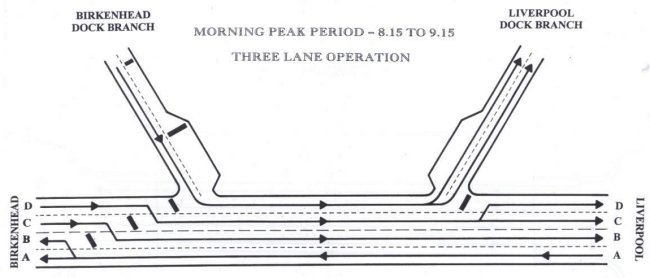
Officers also had to cope with exhaust fumes from many hundred of vehicles in the tunnel as the ventilating systems could not cope with the volume of traffic. If there were no breakdowns or road traffic accidents they would be out of the tunnel in approximately one and a half hours with smarting eyes, needing a wash and something to calm his nerves. During this time at both Liverpool and Birkenhead entrances police officers would be stopping and starting traffic as they came through the pay booths in order to keep the flow of traffic moving in both directions. In these conditions if a breakdown did occur it might take a recovery vehicle an hour to reach the incident, which would cause the traffic to build behind the breakdown in an already congested tunnel. If the breakdown occurred Liverpool and Birkenhead whilst the single lane was in operation Liverpool could become grid locked as far as the outskirts of the city. No matter how far down in the tunnel the breakdown occurred the police would be there to direct traffic around it even if this meant walking to the scene, officers on numerous occasions have spent up to 4 hours working in very hazardous conditions to keep traffic flowing whilst awaiting the arrival of a recovery vehicle. In a situation like this the flow of traffic would just get back to normal when the evenings peak would start and the tidal flow would be put into operation once more between the hours 5.20pm - 6pm only this time, it would be three lanes from Liverpool to Birkenhead AB and C lanes leaving a single D lane Birkenhead to Liverpool. At 6.20pm if the traffic was running smoothly and the exits and entrances at both ends of the tunnel were not congested the police officer on duty at the Liverpool entrance would be given instructions to stand by and close C lane to traffic. These instructions being delivered via radio by a mobile officer who would also be assisting, on his advice the officer on foot would stop traffic in C lane then the police vehicle, displaying it's emergency lights would enter C lane behind the last vehicle to enter that lane. (SEE DIGRAM B) A large direction board would be placed in the middle of C lane and traffic cones placed out guiding drivers into B lane. If a too big a gap occurred between the last vehicle entering the tunnel down that lane and the police vehicle, regular tunnel users would see the gap and assumed that C lane had been opened and cross from D lane into C lane, this happened on a number of occasions, luckily the drivers always saw the police vehicle bearing down on them and they always managed to swerve back into D lane except on one occasion when a mini van collided with a police vehicle head on causing extensive damage to both police vehicle and mini van and injury to both drivers and the passengers in the van, there was nothing the police officer could do to avoid the collision and unfortunately there was no way the officer could take evasive action, if he tried to avoid the mini van by swerving into B lane the traffic in both A & B lanes (although moving at approximately 15-20 mph), is still heavy and motorists being motorists and not keeping a reasonable distance from the vehicle in front are bumper to bumper in both directions.
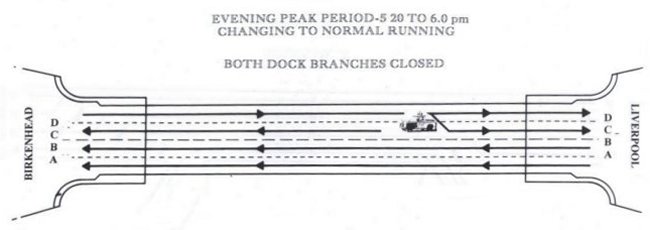
A full investigation carried out and the police officer was completely exonerated, as there was no excuse for the mini van driver to assume that C lane had been opened to traffic from Birkenhead to Liverpool. At Birkenhead entrance traffic cones are placed out filtering traffic into D lane a police officer is also in attendance, so drivers know that C lane is closed to traffic from Birkenhead until he/she either sees the police vehicle in the tunnel travelling in C lane towards Birkenhead and regular tunnel users would cross into C lane behind it, and other drivers would follow or the police vehicle arriving at Birkenhead entrance. When this happens the officer on duty at the Birkenhead entrance removes the traffic cones and directs traffic into C lane. At the Liverpool entrance as soon as the officer sees traffic coming towards him in C lane the filter board and the traffic cones are removed and normal traffic flow resumes in both directions.
By the mid 1960's a new Police HQ and Control room had been built at Birkenhead entrance in addition 14 CCTV cameras had been installed throughout the tunnel and approaches. These cameras greatly assisted the police to pinpoint potential problem areas, which could now be dealt with more speedily and efficiently, but the duties performed on a day-to-day basis during morning and evening peak periods inside and outside the tunnel were to remain until the opening of the Wallasey tunnel in 1971.
Stopping a vehicle inside the Queensway tunnel in order to speak to the driver about an alleged offence can be hazardous as the traffic lanes are only nine foot in width, this practice is frowned upon due to the large number of officers being injured as the result of being hit with external mirrors even rolled between vehicles in adjacent lanes. In normal circumstances the practice is to follow the vehicle out of the tunnel then stop it sometimes this is not practical i.e. if the driver is suspected of driving the vehicle under the influence of alcohol or seen committing the same offence a number of times weaving in and out of lanes for instance changing lanes is an offence. There have been strict guidelines for MT Police because of some times dangerous working conditions. One particular hazard comes to mind, obstacles obstructing the traffic lane that have either fell out of or off vehicles during their passage through the tunnel. If a police officer see an object in a traffic lane the instructions were - on approaching the object stop in front of it, position your vehicle in the centre of both lanes, display blue lights, don't exit the vehicle unless wearing a white coat then retrieve the item safely as quickly as possible. Sometimes it is too late and the object has been ridden over in cases like this if the traffic is light the object could be retrieved quite safely, unfortunately things can sometimes go terribly wrong. In the mid 60's a police officer was on mobile patrol with a colleague, they were travelling down A lane Liverpool to Birkenhead at 7.15am in the process of going around the Georges dock bend (this is where the tunnel bears round to the left opposite Liverpool dock branch).
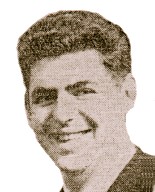 The vehicle passed over an object, because of the bend the officers could not reverse back to carry out the standard procedure and the object had to be removed as it was a long wooden pole with a metal hook used for extracting tray's out of the back of bread bin van's, the officer positioned the vehicle in the centre of both lanes put the blue flashing lights on then his colleague got out of the vehicle, stepped onto the walkway which extends the whole length of the tunnel on both sides, as he walked back to the object he stepped off the walk way and was hit by an heavy goods vehicle which killed him instantly. The HGV then careered into the back of the police vehicle with the other officer inside, knocked it across the tunnel into lane C, fortunately the other police officer and HGV driver only received minor injuries. The then Liverpool City Police had to be called into take charge of the incident, as then MT police did not have the expertise to deal with it. Subsequently the driver and company who employed him were prosecuted for number of offences, one of which being defective breaking system. Mersey Tunnel Police are trained on a regular basis to deal with incidents like this but unfortunately this time it went tragically wrong. The vehicle passed over an object, because of the bend the officers could not reverse back to carry out the standard procedure and the object had to be removed as it was a long wooden pole with a metal hook used for extracting tray's out of the back of bread bin van's, the officer positioned the vehicle in the centre of both lanes put the blue flashing lights on then his colleague got out of the vehicle, stepped onto the walkway which extends the whole length of the tunnel on both sides, as he walked back to the object he stepped off the walk way and was hit by an heavy goods vehicle which killed him instantly. The HGV then careered into the back of the police vehicle with the other officer inside, knocked it across the tunnel into lane C, fortunately the other police officer and HGV driver only received minor injuries. The then Liverpool City Police had to be called into take charge of the incident, as then MT police did not have the expertise to deal with it. Subsequently the driver and company who employed him were prosecuted for number of offences, one of which being defective breaking system. Mersey Tunnel Police are trained on a regular basis to deal with incidents like this but unfortunately this time it went tragically wrong.
The Mersey Tunnel Police have always dealt with road traffic accidents that have occurred with the precincts of the Mersey tunnels this includes the taking of all statements and giving evidence in both Magistrates and Crown courts. In the 1980's fatal RTA's were included and selected officers attended a course in vehicle examination and on successful completion were appointed vehicle examiners under the Road Traffic Act 1988. These officers could now give expert testimony as to any defects on a vehicle that caused the fatality e.g. brake steering defects. In 2002 the Mersey Tunnel Police decided that because of technical difficulties the Department of Transport (DOT), would carry out any future vehicle examinations.

|








|